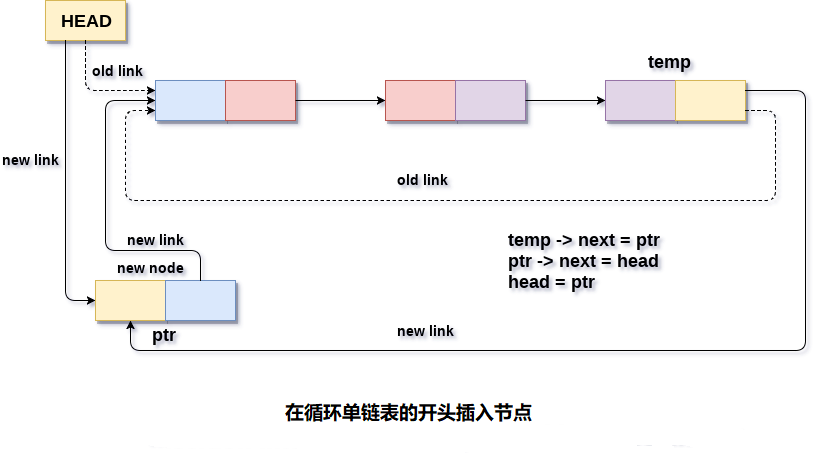在迴圈單連結串列的開頭插入節點
2019-10-16 22:02:55
在開頭將節點插入迴圈單連結串列中有兩種情況。 第一種情況是:節點將插入空連結串列中,第二種情況 是將節點將插入非空的連結串列中。
首先,使用C語言的malloc方法為新節點分配記憶體空間。
struct node *ptr = (struct node *)malloc(sizeof(struct node));
在第一種情況下,條件head == NULL將為true。 因為,插入節點的連結串列是一個迴圈單連結串列,因此連結串列中唯一的節點(只是插入到列表中)將僅指向自身。還需要使頭指標指向此節點。 這將通過使用以下語句來完成。
if(head == NULL)
{
head = ptr;
ptr -> next = head;
}
在第二種情況下,條件head == NULL將變為false,這意味著連結串列至少包含一個節點。 在這種情況下,需要遍歷連結串列才能到達連結串列的最後一個節點。 這將通過使用以下語句來完成。
temp = head;
while(temp->next != head){
temp = temp->next;
}
在迴圈結束時,指標temp將指向連結串列的最後一個節點。 因為,在迴圈單連結串列中,連結串列的最後一個節點包含指向連結串列的第一個節點的指標。 因此,需要使最後一個節點的next指標指向連結串列的頭節點,並且插入連結串列的新節點將成為連結串列的新頭節點,因此temp的next指標將指向新節點ptr。
這將通過使用以下語句來完成。
temp -> next = ptr;
節點temp的next指標將指向連結串列的現有頭節點。
ptr->next = head;
現在,使新節點ptr成為迴圈單連結串列的新頭節點。
head = ptr;
以這種方式,節點ptr可以插入迴圈單連結串列中。
演算法
第1步:IF PTR = NULL
提示 OVERFLOW
轉到第11步
[IF結束]
第2步:設定NEW_NODE = PTR
第3步:SET PTR = PTR - > NEXT
第4步:設定NEW_NODE - > DATA = VAL
第5步:設定TEMP = HEAD
第6步:在TEMP - > NEXT!= HEAD 時重複第8步
第7步:SET TEMP = TEMP - > NEXT
[迴圈結束]
第8步:設定NEW_NODE - > NEXT = HEAD
第9步:SET TEMP→NEXT = NEW_NODE
第10步:SET HEAD = NEW_NODE
第11步:退出
示意圖

C語言範例程式碼 -
#include<stdio.h>
#include<stdlib.h>
void beg_insert(int);
struct node
{
int data;
struct node *next;
};
struct node *head;
void main()
{
int choice, item;
do
{
printf("Enter the item which you want to insert?\n");
scanf("%d", &item);
beg_insert(item);
printf("Press 0 to insert more ?\n");
scanf("%d", &choice);
} while (choice == 0);
}
void beg_insert(int item)
{
struct node *ptr = (struct node *)malloc(sizeof(struct node));
struct node *temp;
if (ptr == NULL)
{
printf("OVERFLOW\n");
}
else
{
ptr->data = item;
if (head == NULL)
{
head = ptr;
ptr->next = head;
}
else
{
temp = head;
while (temp->next != head)
temp = temp->next;
ptr->next = head;
temp->next = ptr;
head = ptr;
}
printf("Node Inserted\n");
}
}
執行上面範例程式碼,得到以下結果 -
Enter the item which you want to insert?
12
Node Inserted
Press 0 to insert more ?
0
Enter the item which you want to insert?
90
Node Inserted
Press 0 to insert more ?
2